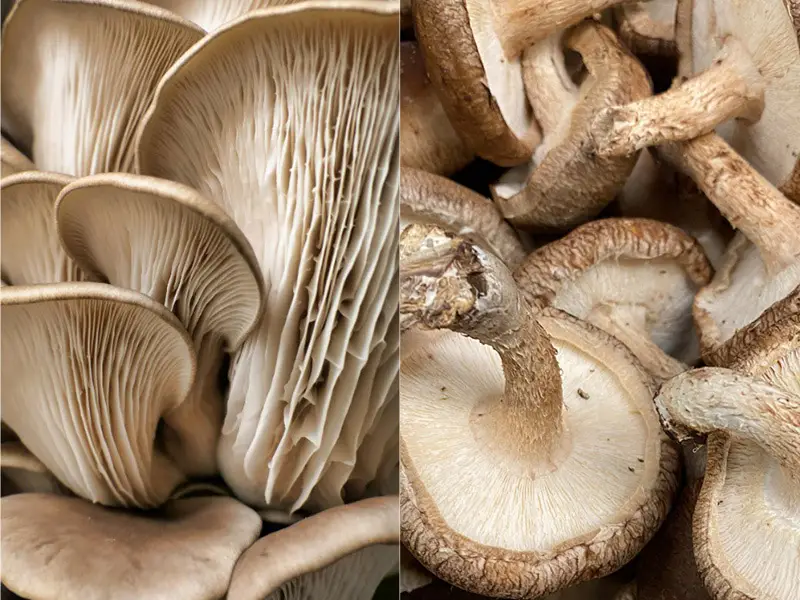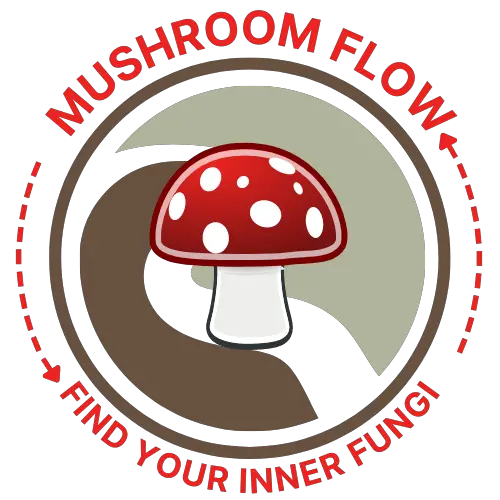Did you know mushrooms are more closely related to humans than they are to plants? These fun guys (pun intended) have piqued the interest of humans for millennia, being used for anything from religious ceremonies to grandma’s casseroles. Scientists have only just begun to understand these tightly woven strands of mycelium.
Shiitake (Lentinula edodes) and Oyster (Pleurotus ostreatus) mushrooms, while both delicious and edible, are not the same mushroom variety. Shiitake and Oyster mushrooms differ in appearance, taste, medicinal properties, and even shelf-life.
Although there are many different kinds of edible mushrooms including shiitake and oyster mushrooms, white button mushrooms are what many think of as the standard culinary mushroom. Let’s dive deeper into two of the more gourmet varieties: shiitake and oyster mushrooms.

What Are The Differences Between Shiitake and Oyster Mushrooms?
| Qualities | Shiitake Mushrooms | Oyster Mushrooms |
|---|---|---|
| Flavor | Deep, woodsy, umami | Mild, nutty |
| Appearance | Dark to light brown, flat circular cap | Multiple colors, oyster shell shape |
| Benefits | Anti-inflammatory, anti-oxidant, vitamins B, D, fiber, protein | Anti-inflammatory, anti-oxidant, vitamins B6, niacin, riboflavin, fiber, high in protein |
Appearance
Shiitake mushroom: The Shiitake mushroom starts out as a dark, earthy brown color, but as it matures the color softens, and cute white spots develop. The gills underneath are white, but not too noticeable when just looking at the mushroom.
The cap itself is circular, and while it protrudes when young it later becomes more even and flat at maturity. It has a stem that looks similar to the stem of a button mushroom. These mushrooms give the impression that a fairy may be hiding right behind them, ready to peek out at any time.
Oyster mushroom: The oyster mushroom is more elaborate when it comes to design. You can find these mushrooms sporting bright colors such as pink and yellow or boasting more somber colors such as gray and dark blue.
They sprout out sideways from the substrate they grow in (such as coffee grounds), forming a shape similar to an oyster shell. This is, in fact, where the oyster mushroom gets its name.
The cap doesn’t ever become evenly centered over the stem-like the shiitake or button mushrooms. Instead, it leans to one side. The gills are half the show since they are so beautifully displayed as the cap grows upward.
Flavor
Shiitake mushroom: Shiitake mushrooms have a deep, complex flavor that has been often described as umami, a Japanese phrase for a ‘fifth flavor’ beyond sour, salty, sweet, or bitter.
However, it is similar to the depth of flavor of raw tomato. How you prepare the shiitake mushroom helps define what it will taste like. Although shiitakes can be consumed raw, certain individuals may be sensitive to them. When cooked, shiitakes offer a rich flavor and smell.
You can prepare this mushroom by allowing it to steep in a hot broth. When prepared this way, the shiitake mushroom tanginess is more pronounced. When it is more thoroughly cooked it becomes more buttery and meaty. This mushroom is really excellent as part of a stir-fry.
Oyster mushroom: Oyster mushrooms have a more mild flavor. It is nuttier in nature and soaks up the flavor of the broth it is cooked in. This mushroom is a good one to add to any meal, as it absorbs the flavors of the other ingredients and provides a meaty texture that is enjoyable to eat.
Benefits
Shiitake mushroom: Surprisingly, shiitake mushrooms are renowned for their health capabilities. They do this by producing compounds such as Lentinan and KS-2. These powerful mushrooms have also shown promise in being anti-viral. Scientists have used fermented extracts from shiitake mushrooms to help slow the effects of some conditions.
Oyster mushroom: Not to be shown up by its shiitake cousin, the oyster mushroom also has unique medicinal qualities by producing a compound known as Lovastatin, which can help certain conditions.
Shelf life
While both of these mushrooms may be delicious, one thing that is probably important to you and most home cooks is shelf-life. Shiitake mushrooms have a longer shelf-life than oyster mushrooms. The longer shelf life makes shiitake mushrooms an ideal candidate for people who plan meals and buy ingredients in advance.
Can You Substitute Shiitake for Oyster Mushrooms?
With these differences in mind, you can substitute shiitake for oyster mushrooms. However, keep in mind that your meal will be slightly different. The complex, meaty flavor of the shiitake will replace the calmer flavor of the oyster mushroom.
If you are going to use oyster mushrooms you will need to make your meal sooner than if you were to use shiitake mushrooms. The preparations for your meal will probably be slightly different as well.
Choosing one mushroom over the other is ultimately a choice of preference. There is no wrong choice because both shiitake and oyster mushrooms are tasty in their own right.
Can You Grow Shiitake and Oyster Mushrooms at Home?
Something to consider is that you can grow your own fresh mushrooms at home! There are techniques that range from beginner to advanced grower. Home kits are the best way to begin for most hobbyists who just want to have fresh mushrooms and support mushroom farmers.
Looking for an easy way to grow mushrooms at home? Check out these fun grow kits on Amazon.
These kits are very intuitive and fun. You not only get to have fresh mushrooms but can involve the whole family in mushroom madness. The instructions for each kit are usually displayed on its case. You also get the added benefit that these kits have a high success rate as long as the instructions are followed.
For people with mushroom mania, there are plenty of affordable mushroom-growing, DIY projects. One such project involves a 5-gallon bucket, straw, mushroom mycelium, and a power tool.
The following video explains how to put together this simple project:
Other projects become slightly more complicated. In addition, it is good to note that oyster mushrooms are easier to cultivate than shiitake mushrooms.
Final Thoughts
The mushroom world is diverse and beautiful. Shiitake and oyster mushrooms are similar in purpose but differ in appearance, flavor, medicinal properties, and shelf-life. Using one over the other is more a matter of preference and how available it is at your location.
You can buy these gourmet mushrooms at a local store or farmer’s market, or you can grow them yourself. The choice is yours to make– and it’s an exciting one!
Sources:
Mycelium Running and Growing Gourmet and Medicinal Mushrooms written by Paul Stamets. If you are interested in mushroom cultivation then these are good places to start.
